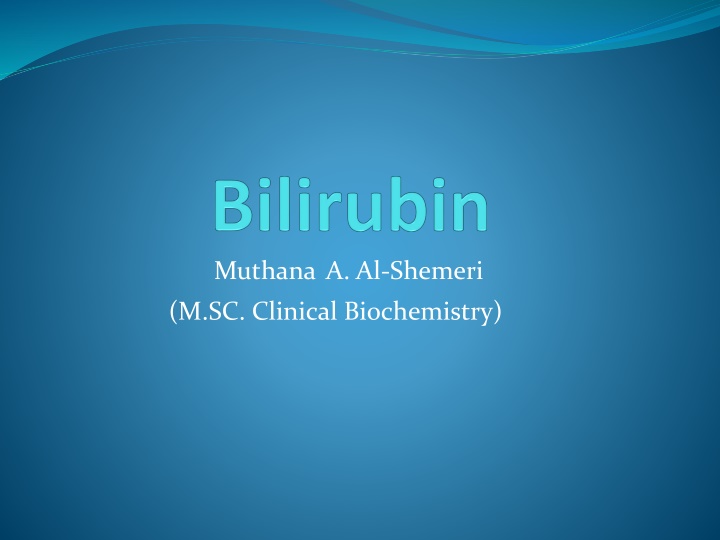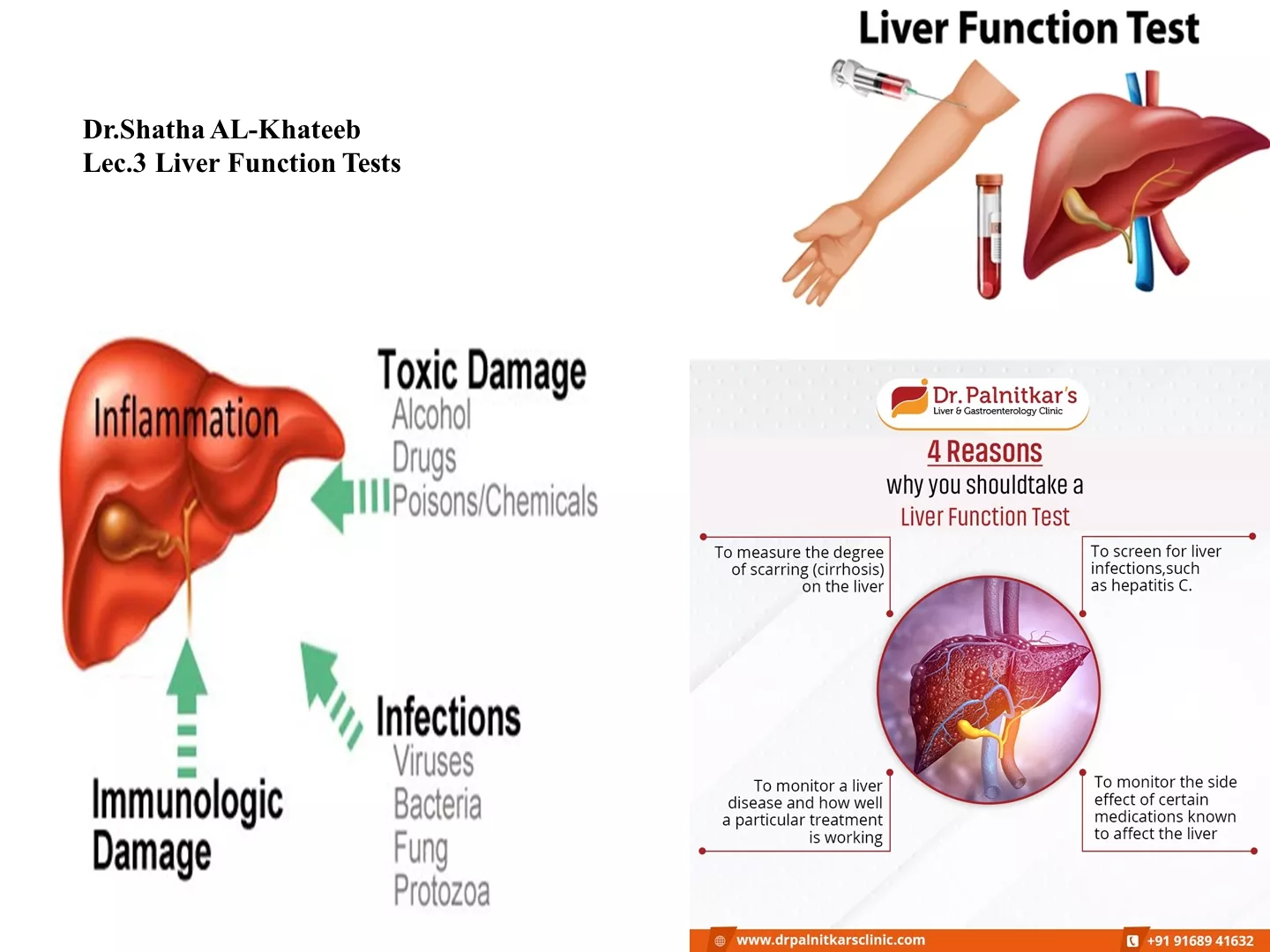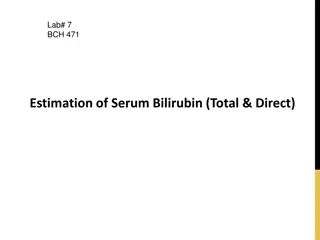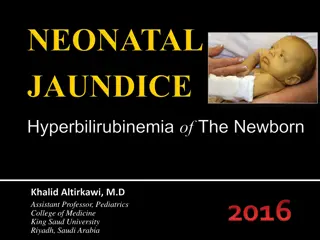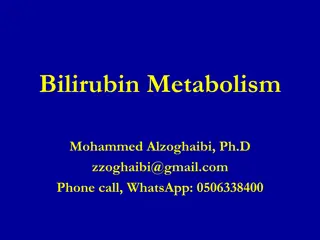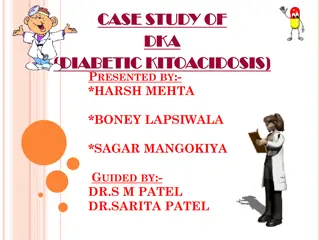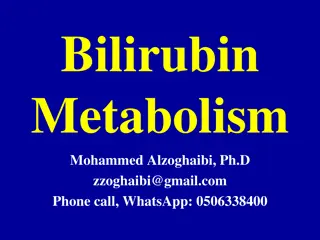Bilirubin: Why and When to Get Tested
Bilirubin is a crucial pigment for the liver, with abnormal levels indicating various health issues. This test measures bilirubin levels to screen and monitor liver disorders. Learn about its production, testing methods, reactions, and significance in diagnosing conditions like jaundice.
Download Presentation

Please find below an Image/Link to download the presentation.
The content on the website is provided AS IS for your information and personal use only. It may not be sold, licensed, or shared on other websites without obtaining consent from the author.If you encounter any issues during the download, it is possible that the publisher has removed the file from their server.
You are allowed to download the files provided on this website for personal or commercial use, subject to the condition that they are used lawfully. All files are the property of their respective owners.
The content on the website is provided AS IS for your information and personal use only. It may not be sold, licensed, or shared on other websites without obtaining consent from the author.
E N D
Presentation Transcript
Muthana A. Al-Shemeri (M.SC. Clinical Biochemistry)
At a Glance Why Get Tested? To screen for or monitor liver disorders When to Get Tested? If your doctor thinks you have signs or symptoms of liver damage, liver disease, bile duct blockage, hemolytic anemia, or a liver-related metabolic problem
Sample Required? In adults, a blood sample from a vein in the arm; in newborns, a blood sample from a heelstick; non-invasive technology is available in some health care facilities that will measure bilirubin by using an instrument placed on the skin (transcutaneous bilirubin meter) Test Preparation Needed? None
The Test Sample What is being tested? Bilirubin is an orange-yellow pigment found in bile. Red blood cells (RBCs) normally degrade after 120 days in the circulation. At this time, a component of the RBCs, hemoglobin breaks down into unconjugated bilirubin. Approximately 250 to 350 mg of bilirubin is produced daily in a normal, healthy adult, of which 85% is derived from damaged or old red cells that have died, with the remaining amount from the bone marrow or liver. Unconjugated bilirubin is carried to the liver, where sugars are attached to it to make it water soluble, producing conjugated bilirubin. This conjugated bilirubin is passed to the bile by the liver and is further broken down by bacteria in the small intestines and eventually excreted in the feces. The breakdown products of bilirubin give feces its characteristic brown color. If bilirubin levels increase in the blood, the appearance of jaundice becomes more evident. Normally, almost all bilirubin in the blood is unconjugated.
Abb. Name(s) Water Soluble? Reaction Reacts quickly when dyes (diazo reagent) are added to the blood specimen to produce "Direct bilirubin" Reacts more slowly. Still produces azobilirubin. Ethanol makes all bilirubin react promptly then calc: Indirect bilirubin = Total bilirubin - Direct bilirubin "Conjugated" or "Direct bilirubin" Yes (bound to glucuronic acid) "BC" "Unconjugated" or "Indirect bilirubin" "BU" No
How is the sample collected for testing? In newborns, blood is often collected from a heelstick, a technique that uses a small, sharp blade to cut the skin on the infant s heel and collect a few drops of blood into a small tube. For adults, blood is typically collected by needle from a vein. (transcutaneous bilirubin meter). Is any test preparation needed to ensure the quality of the sample? No test preparation is needed.
Measurement methods Originally the Van den Bergh reaction was used for a qualitative estimate of bilirubin. There are a variety of methods to measure bilirubin. Total bilirubin is now often measured by the 2,5- dichlorophenyldiazonium (DPD) method, and direct bilirubin is often measured by the method of Jendrassik and Grof. Blood levels There are no normal levels of bilirubin as it is an excretion product, and levels found in the body reflects the balance between production and excretion. Different sources provide reference rangeswhich are similar but not identical. Some examples for adults are provided below (different reference ranges are often used for newborns): umol/L mg/dL 0.2-1.9,[8]0.3 1.0,[7] 0.1-1.2[9] 0-0.3,[8]0.1 0.3,[7]0.1- 0.4[9] total bilirubin 5.1 17.0 [7] direct bilirubin 1.0 5.1 [7]
How is it used? When bilirubin levels are high, a condition called jaundiceoccurs, and further testing is needed to determine the cause. Too much bilirubin may mean that too much is being produced (usually due to increased hemolysis) or that the liver is incapable of adequately removing bilirubin in a timely manner due to blockage of bile ducts, liver diseases such as cirrhosis, acute hepatitis, or inherited problems with bilirubin processing.
It is common to see high bilirubin levels in newborns, typically 1 to 3 days old. This is sometimes called physiologic jaundice of the newborn. Within the first 24 hours of life, up to 50% of full-term newborns, and an even greater percentage of pre- term babies, may have a high bilirubin level. After birth, newborns begin breaking down the excess red blood cells (RBCs) they are born with and, since the newborn s liver is not fully mature, it is unable to process the extra bilirubin, causing the infant's bilirubin levels to rise in the blood and other body tissues. This situation usually resolves itself within a few days. In other instances, newborns red blood cells may be being destroyed because of blood incompatibilities between the baby and her mother, called hemolytic disease of the newborn.
In adults or older children, bilirubin is measured to diagnose and/or monitor liver diseases, such as cirrhosis, hepatitis, or gallstones. Patients with sickle cell diseaseor other causes of hemolytic anemia may have episodes where excessive RBC destruction takes place, increasing bilirubin levels.
